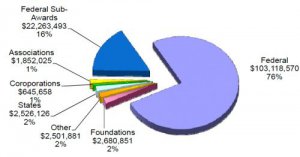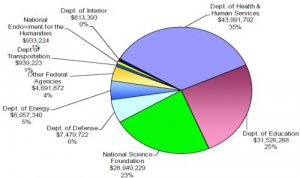 EUGENE, Ore. -- (Sept. 3, 2010) -- University of Oregon researchers brought in a record $135.6 million in competitively awarded external funding -- most from federal agencies -- in 2009-2010, boosted by $23.2 million in 38 stimulus awards under the American Recovery and Reinvestment Act (ARRA).
EUGENE, Ore. -- (Sept. 3, 2010) -- University of Oregon researchers brought in a record $135.6 million in competitively awarded external funding -- most from federal agencies -- in 2009-2010, boosted by $23.2 million in 38 stimulus awards under the American Recovery and Reinvestment Act (ARRA).
 The record total, which reflects external funding obtained by way of 610 grants, contracts and other competitive awards, was an almost 18 percent increase over the previous high of $115.3 million. The stimulus funding represented 17.1 percent of the record total and helped fuel an increase of $35.1 million over funding received by researchers in 2008-2009.
The record total, which reflects external funding obtained by way of 610 grants, contracts and other competitive awards, was an almost 18 percent increase over the previous high of $115.3 million. The stimulus funding represented 17.1 percent of the record total and helped fuel an increase of $35.1 million over funding received by researchers in 2008-2009.
In the last decade, the UO's annual totals rose from $57.8 million in 2001 to this year's record -- a 135 percent increase. The 610 funded grants in Fiscal 2010 went to 255 principal investigators (project leaders).
Research expenditures were a record $115.6 million in FY 2010, a 4.8 percent increase over the previous year. Expenditures, which in the just-completed year covered 994 active grants, are not directly comparable to annual award totals because such spending relates to grants that often cover multiple years.
The UO's growth in research expenditures (137 percent) over the past decade is 11th best among the 63 member institutions of the Association of American Universities (AAU).
From fiscal years 2003 to 2008 -- the most recent national data available from the National Science Foundation -- research expenditures per UO faculty member increased by 50 percent, which is third best in the AAU. The UO is one of only two AAU members in the Pacific Northwest that are included in the leading organization of premier research universities nationally.
"Compared to most AAU institutions, UO is small, but it is increasing its market share of external funding to support its core strengths in basic research,” said Richard Linton, UO’s vice president for research and graduate studies. The funding, he added, also supports undergraduate and graduate student research, and helps the UO attract highly capable students who will be the foundation for U.S. competitiveness in the decades to come.
At a glance, the UO totals appear low compared to year-end reports issued by the state's two other leading research institutions. However, the $275 million in external funding at Oregon State University and the $392 million at Oregon Health and Science University -- both records -- reflect the institutions' very different missions, Linton said.
"We're fortunate in that Oregon has a portfolio including a medical university (OHSU) that draws federal funding primarily from the National Institutes of Health, a land-grant institution (OSU) where about half of its funding is in the important areas of agriculture and engineering, and the UO, which has Oregon’s leading liberal arts, basic science and education research programs," Linton said. "We have three major research institutions with distinctly different missions, external funding opportunities, and impacts."
At the UO in Fiscal 2010, 35 percent ($44 million) of external funding to researchers came from the U.S. Department of Health and Human Services, of which the NIH is a leading division. Another 25 percent ($31.5 million) came from the U.S. Department of Education. Rounding out the UO's big three federal funders was the National Science Foundation, which provided 23 percent ($28.9 million). About 56 percent of the federal funding went to centers and institutes that report to the vice president for research. Most of the external funding is the result of competitively awarded grants to faculty in UO’s College of Arts and Sciences and College of Education.
Similar to OHSU and OSU, the UO benefited substantially from the short-term federal stimulus programs. "We had a brief window of opportunity with the stimulus," Linton said. "Our faculty stepped up by submitting many ARRA proposals, notably to NIH and NSF, and had considerable success in realizing additional grant dollars for their research efforts. Most of the reinvestment monies in ARRA were focused on science and engineering research, so we benefited from the additional NSF and NIH funding made available.”
Linton also noted that stimulus dollars from the NSF and NIH provided more than $10 million to the UO during a down economy, allowing for the acquisition of important pieces of equipment and facility improvements that for many years will boost research in several areas and help support jobs. NIH stimulus funding included $9.1 million to help the UO expand and improve its core research facilities, he said.
Among stimulus grants from the NSF was $2 million to Allen Malony, professor of computer and information science. Malony and collaborators in four academic fields are adding computer-related infrastructure, including analyses capabilities, data storage space and bandwidth. The improvements potentially will benefit researchers in computer science, psychology, biology, chemistry and physics, who often work together in cross-disciplinary projects.
A $515,000 award to chemists Mark Lonergan and George Nazin allows for a state-of-the-art scanning tunneling microscope specially adapted to provide enhanced viewing of energy transfer in molecular, polymer and nanoscale systems, as well as on the formation of chemical bonds.
A $750,000 grant to chemist David Johnson allowed the purchase of dual ion beam equipment important to nanofabrication and materials research. The equipment was sought for use for eight projects involving materials science, physics, chemistry, geology and anthropology projects at both the UO and OSU. The equipment also will be used for training students, other researchers and industry partners.
The equipment purchased under the Lonergan and Johnson grants will be housed in the Center for Advanced Materials Characterization in Oregon (CAMCOR) in the Lorry I. Lokey Laboratories. CAMCOR is a shared-user facility available to outside researchers and industry and associated with the Oregon Nanoscience and Microtechnologies Institute (ONAMI).
Another grant, $500,000 to chemist Michael Haley allows for significant upgrades to two nuclear magnetic resonance spectrometers. These allow for in-depth studies of molecular structure and will enhance a variety of projects in chemistry, materials science and biology.
"Federal research dollars provide tremendous economic benefits," Linton said. "First, this external funding pays the salaries of UO researchers, postdoctoral associates, graduate students, technical support staff and research associates. The researchers’ salaries, in turn, feed the local economy and the fruits of their research fuel innovation that directly impacts Oregonians and the nation."
That innovation, Linton noted, resulted in $26 million total revenue in 2009-2010 generated by 16 Oregon-based companies whose intellectual property portfolios are tied to the UO. That revenue has risen almost five-fold in the past five years, Linton said. These companies employ 237 people, almost all of them in Oregon. In addition to delivering a steadily growing contribution to Oregon's economy through successful new enterprises, the UO's overall innovation-derived income (e.g., royalties, licensing revenue) -- almost all of which flows into UO from regions outside Oregon -- reached a new record of $7.5 million in 2010, a 24-fold increase in the last decade, Linton said.
Five spin-off companies with direct UO origins currently are in the university's Riverfront Research Park, where another 17 private companies are also housed. The research park has been home to 69 tenant companies, 22 of which were start-ups created as a direct result of UO faculty or student innovations or as a consequence of a UO research discovery. Entities now in the research park employ some 400 employees -- and as many students -- with an annual payroll of $20 million. The start-ups and private companies at the Riverfront Research Park encompass neuroscience, biotechnology, behavioral science, optimization technology, health care, reading program development, and policy and program development for people with disabilities. Their close proximity promotes on-going collaborative relationships with UO researchers, faculty and staff.